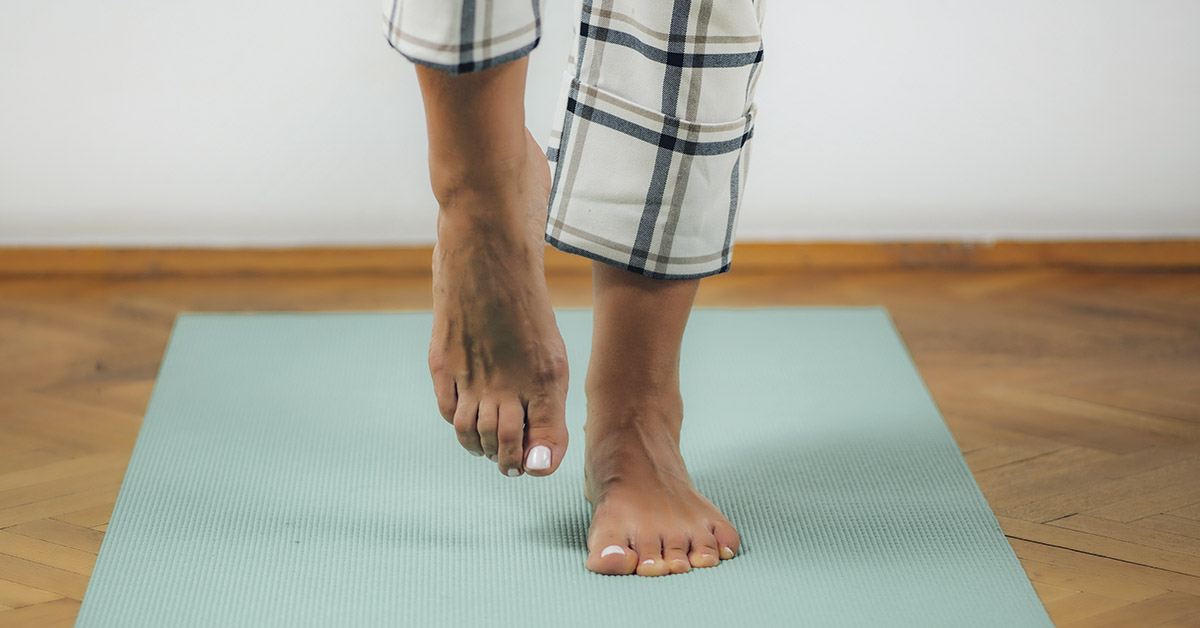Your ability to balance on one foot may indicate your life expectancy, according to a new peer-reviewed study. In a nutshell, if you can balance on one foot for 10 seconds, you are more likely to live longer. Balance ability tends to naturally continue to age 70, so the 10-second test may seem more of a broad indicator of life expectancy based on age instead of aerobic finesse. But it’s more than just an age test; poor balance can point to serious health declines.
The Balance Test That Indicates Life Expectancy
Musculoskeletal fitness can indicate a lot about a person’s health, especially when underlying issues are present. For instance, poor balance has been linked to increasing frailty in older adults, according to Dr. Claudio Gil Araújo. He’s the lead author of the study and a sports and exercise physician at the Exercise Medicine Clinic Clinimex in Rio de Janeiro.
“If you are younger than 70 years, you are expected (as the majority of those at that age) to successfully complete the 10 seconds,” Araújo said. “For those older than 70 years of age, if you complete it, you are in better static balance status than your age-peers. …The advantages of the 10s OLS test include the fact that it is simple and it provides rapid, safe and objective feedback for the patient and health care providers regarding static balance.” Therefore, Araújo recommends everyone to implement a 15-second balance test into their morning routines as a way to regularly gauge their physical well being. [1]
The study focused on 1,702 participants aged 51 to 75, with the average age around 61. All of them were able to walk steadily. The first checkup occurred in 2008 and accounted for the participants’ weight, waist size, and body fat. Then they were told to stand on one leg for 10 seconds without any support. They stood with the lifted foot on the back of the opposite leg with their arms by their sides and their gaze straight ahead. They had three tries and could choose which leg to balance on. However, one in 5 were unable to complete the test.
Balance and Health Issues
The older participants on average, were more likely to fail the test, as were those with diabetes, weight issues, cardiovascular disease, and other health concerns. The researchers had factored in details like sex, age, BMI, diabetes, high cholesterol, hypertension, and history of heart disease. In conclusion, those who failed the balance test had an 84% heightened risk of death within the next decade. [2]
However, the case has its limitations. “This is an observational study, and as such, can’t establish cause,” said Araújo. “As participants were all white Brazilians, the findings might not be more widely applicable to other ethnicities and nations, caution the researchers.”
“It is important to remember that the study found a correlation, not a cause-and-effect relationship,” said Anat Lubetzky, PT, PhD, CSCS, an associate professor in the Department of Physical Therapy at New York University. “Typically, a person in their 50s should be able to balance on one leg for around 40 seconds. Someone in their 60s is looking at 20 seconds, and someone in their 70s is around 10 seconds. Static balance is a multidimensional issue and there are numerous causes, such as neurological disease, orthopedic issues, vision, spatial issues, a sedentary lifestyle, reaction time, cognition, and other health problems. If it is difficult to balance on one leg, you should think about your overall health and fitness.” [3]
Poor balance presents its own danger. It increases the risk of falls, which are the second leading cause of unintentional injury deaths all over the world, according to the World Health Organization. Each year, over 37 million falls are severe enough to warrant medical help. But moreover, balance can be affected by many health issues from pinched nerves to inner ear issues. This is why the study author’s advocate for balance tests to become part of regular doctor checkup.
How to Improve Balance and Endurance
But this study isn’t the first to measure everyday tasks in terms of life expectancy. For instance, previous research found that grip strength is another indicator of mortality; if fact, people with the weakest grip had a rate of death 1.67 times larger than those with the strongest grip. Walking speed is another indicator, with the slowest walkers’ rate of death 2.87 times higher than the fastest walkers. Even something as simple as getting out of a chair can be an indicator, as studies found that the slowest group had a death rate twice of those in the fastest group. Overall, these studies point to specific tasks that people with poor health would have more difficulty completing than those in good health.
“It’s essential to identify health problems that could be negatively affecting balance and correct them if possible,” said Dr. Adam Rivadeneyra, a primary care sports medicine physician. “If the patient is healthy, balance can be improved with practice or focused physical therapy to improve strength, endurance, and coordination.”
Fortunately, there are many ways to improve balance. Unsurprisingly, they all involve exercise — a crucial part of an overall healthy lifestyle. Specific balance-strengthening activities include walking, biking, stair-climbing, yoga, tai chi, and stretches to loosen tight muscles.
Keep Reading: Statins lower the risk of one of the deadliest kinds of strokes, study finds
Sources
- “Balancing on one leg for 10 seconds may predict likelihood of living or dying, study says.” USA Today. Scott Gleeson. June 23, 2022
- “Successful 10-second one-legged stance performance predicts survival in middle-aged and older individuals.” BMJ Journals. Claudio Gil Araújo. June 21, 2022
- “Can You Stand on One Leg for 10 Seconds? What that Tells You About Your Overall Health.” Healthline. Eileen Bailey. June 21, 2022
- “Easy ways to improve your balance.” Harvard Health Publishing. May 6, 2021

